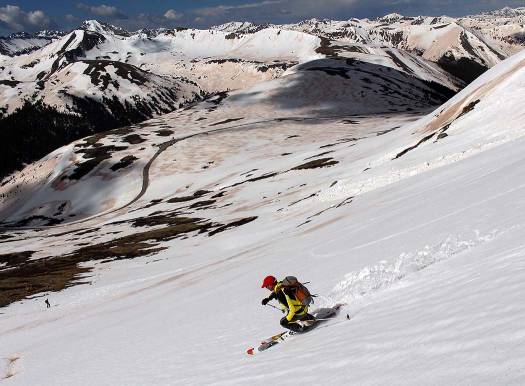Recommended: D System Ski Descent Rating Method
A simple system of “easy, moderate, hard, extreme” works well for rating a ski or splitboard climb. Rating the downhill is tougher. Many guidebooks over-simplify, while a few take the risk of using a true rating system. One method is the European S System (also known as the Traynard System). It’s based mostly on slope angle, and just as rock ratings assume dry conditions, so the S system assumes reasonable snow.

Skiing Independence Pass, Colorado. This route would rate about S4-.
The S system was first proposed for North American use in the 1980s by guide Bela Vadaz, it was expanded by guidebook author Louis Dawson in 1998 to include a +/- split for each level, and first published in the Chuting Gallery Wasatch guidebook by Andrew McLean. The problem with the system now is that it needs more levels around the 45 degree angle, so thus may need a shift lumping the easier/flatter terrain in a broader category. Here at WildSnow.com we do NOT recomend using S System for rating ski descents, it is too limited. Check out our D System, it’s better (see link above).
Again, please note that this Modified S System is NOT RECOMMENDED and is detailed here for the historical record. For a fresh new and effective rating system, see the D System.
Difficult surfaces, such as ice or breakable crust, will make the route harder than the indicated rating. As with rock climbing rating, it’s assumed that the snow is in reasonable condition, ice or difficult snow would change the rating. All ratings assume the competent use of your chosen glisse method: telemark or latched heel skis, or snowboard.
Flat ground or slightly rolling terrain. Usually a flat
ski tour or nordic trail. All hills can be easily descended
on foot or with novice downhill technique.
Easy. Low-angled.. Only novice downhill technique required.
Slightly harder than S1.
Angle up to 25 degrees. Easy terrain such as broad slopes.
Ability to sideslip and stem-turn will get you down. Avalanches
unlikely or impossible.
Longer pitches than S2-, can be a steep narrow trail or
actual glisse descent. Up to 25 degrees. Novice skiers
or snowboarders can handle this terrain with basic technique.
Angle near or at 25 degrees, but rougher terrain or difficult
snow requires more technique.
Slopes up to 30 degrees, similar to an easy "expert" run
at a resort. Avalanches uncommon but possible with unstable
snow.
Slopes around 35 degrees, similar to an "expert" run
at a resort. A skier or rider capable of S3 should have
solid technique in any type of snow. This is often prime
avalanche terrain. Example: Tuning Fork on Torrey’s Peak,
Colorado, via easiest entrance at looker’s right.
Same angle as S3 (around 35 degrees); but terrain features
(dogleg turns, rollovers, trees, ridges, etc.) make the
skiing slightly more difficult. Again, this is prime avalanche
terrain.
Slopes over 35 degrees but under 45 degrees, without terrain
obstacles and with safe runouts. Avalanche danger is always
a concern.
Slopes over 35 degrees but under 45 degrees, usually steeper
than an S4-, may have fall potential and terrain obstacles
such as narrows. Avalanche danger always a concern.
Slopes just under 45 degrees, may have fall potential and
terrain obstacles. S4+ is borderline extreme skiing and
snowboarding. Avalanches are slightly less common on these
slopes, but nonetheless occur enough to be a concern.
Slopes at 45 degrees or slightly over. Fall potential on
firm snow. This is bonafide extreme skiing. Because snow
can’t easily accumulate at these angles, slab avalanches
are less common, but can occur. Loose snow avalanches are
common.
Slopes between 45 degrees and 55 degrees. Technique for
steep terrain required if turns are made. Fall potential
almost always present. Loose snow avalanches are common,
especially after new snow accumulations; slab avalanches
are uncommon.
Most of the route near or at 55 degrees. This is technical
extreme terrain. Fall potential always exists. Death from
a fall likely if steep sections are long. Loose snow avalanches
are common, especially after new snow accumulations; slab
avalanches are uncommon.
Short sections steeper than 55 degrees. Loose snow avalanches
are common, especially after new snow accumulations; slab
avalanches are uncommon.
Most of the route steeper than 55 degrees. This is extreme
terrain that’s safe for only the elite athlete if turns
are made. Sideslipping and ropework may be mandatory. Loose
snow avalanches are common, especially after new snow accumulations;
slab avalanches are uncommon.
Same angles as S6, but with extenuating circumstances,
such as cliffs, icefalls, and other obstacles. Avalanches
are the least of your concerns. You might be better off
on crampons so you can claim a first ascent.
A number of sections approaching 60 degrees steep; short
sections may be 60 degrees. Fall potential a given. Avalanches?
Who cares.
Much of the route is around 60 degrees steep. Ropework
may be optional or mandatory and should be clarified in
rating and text description. Any avalanches probably happened
before you got there.
Same angles as S7, with skiable snow connected by technical
maneuvers such as small jumps. Ropework may be optional
or mandatory and should be clarified in rating.
WildSnow.com publisher emeritus and founder Lou (Louis Dawson) has a 50+ years career in climbing, backcountry skiing and ski mountaineering. He was the first person in history to ski down all 54 Colorado 14,000-foot peaks, has authored numerous books about about backcountry skiing, and has skied from the summit of Denali in Alaska, North America’s highest mountain.
